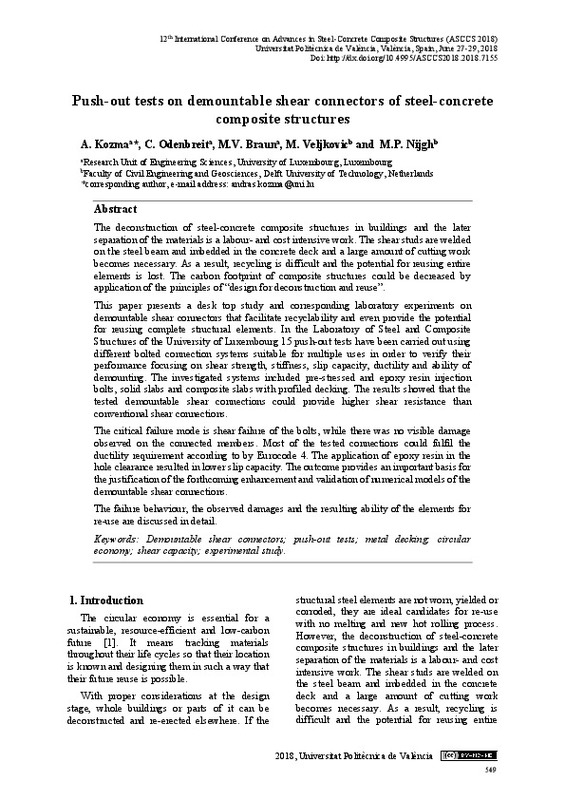Kozma, A.; Odenbreit, C.; Braun, M.; Veljkovic, M.; Nijgh, M. (2018). Push-out tests on demountable shear connectors of steel-concrete composite structures. En Proceedings of the 12th International Conference on Advances in Steel-Concrete Composite Structures. ASCCS 2018. Editorial Universitat Politècnica de València. 549-556. https://doi.org/10.4995/ASCCS2018.2018.7155
Por favor, use este identificador para citar o enlazar este ítem: http://hdl.handle.net/10251/108374
|
Título:
|
Push-out tests on demountable shear connectors of steel-concrete composite structures
|
|
Autor:
|
Kozma, Andras
Odenbreit, Chirstoph
Braun, Matthias
Veljkovic, Milan
Nijgh, Martin
|
|
Fecha difusión:
|
|
|
Resumen:
|
[EN] The deconstruction of steel-concrete composite structures in buildings and the later separation of the materials is a labour- and cost intensive work. This is due to the fact, that the shear studs are welded on the ...[+]
[EN] The deconstruction of steel-concrete composite structures in buildings and the later separation of the materials is a labour- and cost intensive work. This is due to the fact, that the shear studs are welded on the steel beam, and a large amount of cutting work gets necessary. As a result, recycling is difficult and the potential for reusing entire elements is lost. The carbon footprint of composite structures could be decreased by the application of the principles of “design for deconstruction and reuse”. This paper presents a study with its respective laboratory experiments on demountable shear connectors that facilitate recyclability and even offer the potential for reusing elements in their entirety. In the Laboratory of Steel and Composite Structures of the University of Luxembourg 15 push-out tests have been carried out using different bolted connection systems suitable for multiple uses in order to verify their performance characteristics by means of shear strength, stiffness, slip capacity, ductility and ability of demounting. The investigated systems included pre-stressed and epoxy resin injection bolts, solid slabs and composite slabs with profiled decking. The results showed that the tested demountable shear connections could provide higher shear resistance than conventional shear connections in some cases. The connection failure happened in the bolts, while there was no or minor visible damage observed on the connected members. Most of the tested connections could fulfil the ductility requirement given by Eurocode 4. The application of epoxy resin in the hole clearance resulted in lower slip capacity. The outcome will provide an important basis for the calibration of the forthcoming enhancement and numerical simulation of the demountable shear connections. The failure behaviour, the observed damages and the resulting ability of the elements for later re-use are discussed in detail.
[-]
|
|
Palabras clave:
|
Demountable shear connectors
,
Push-out tests
,
Metal decking
,
Circular economy
,
Shear capacity
,
Experimental study
|
|
Derechos de uso:
|
Reconocimiento - No comercial - Sin obra derivada (by-nc-nd)
|
|
ISBN:
|
9788490486016
|
|
Fuente:
|
Proceedings of the 12th International Conference on Advances in Steel-Concrete Composite Structures. ASCCS 2018.
|
|
DOI:
|
10.4995/ASCCS2018.2018.7155
|
|
Editorial:
|
Editorial Universitat Politècnica de València
|
|
Versión del editor:
|
http://ocs.editorial.upv.es/index.php/ASCCS/ASCCS2018/paper/view/7155
|
|
Título del congreso:
|
12th international conference on ‘Advances in Steel-Concrete Composite Structures’ - ASCCS 2018
|
|
Lugar del congreso:
|
Valencia, Spain
|
|
Fecha congreso:
|
Junio 27-29,2018
|
|
Código del Proyecto:
|
info:eu-repo/grantAgreement/RFCS//710040/
|
|
Agradecimientos:
|
The research leading to these results is a part of a common project of Steel Construction Institute, University of Luxembourg, University of Bradford, Lindab, Tata Steel, Bouwen met Staal, Delft University of Technology ...[+]
The research leading to these results is a part of a common project of Steel Construction Institute, University of Luxembourg, University of Bradford, Lindab, Tata Steel, Bouwen met Staal, Delft University of Technology and AEC3. The project has received funding from the Research Fund for Coal and Steel under grant agreement No 710040.
[-]
|
|
Tipo:
|
Capítulo de libro
Comunicación en congreso
|








